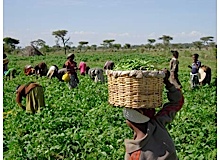 FAC member John Thompson reflects on the 2008 World Food Summit, arguing that any solutions will require the international community to move beyond simple, short-term technical or market ‘fixes’ and address the political economy of food and agriculture.
FAC member John Thompson reflects on the 2008 World Food Summit, arguing that any solutions will require the international community to move beyond simple, short-term technical or market ‘fixes’ and address the political economy of food and agriculture.
When the Chief Executives Board of the United Nations met in Bern, Switzerland, in late April 2008 to assess how the international community could best contribute to combating the global food crisis, they agreed to set up a High Level Task Force, chaired by the UN Secretary General, with the Director General of the FAO as the Vice Chair. The Task Force is composed of the heads of the relevant UN specialised agencies, funds and programmes, the Bretton Woods Institutions (World Bank, International Monetary Fund), and relevant parts of the UN Secretariat. The aim was to promote a unified response to this huge challenge.
The first objective of the Task Force has been to produce a clear plan of action, known as the ‘Comprehensive Framework for Action (CFA)’. Key elements of the CFA were presented to leaders from 151 countries who are participating in the UN’s High-Level Conference on Food Security: the Challenges of Climate Change and Bioenergy in Rome.
Following several days of intensive negotiations, a draft declaration on how to resolve the current food crisis has been circulating among delegates. The final declaration will be released at the close of the conference on 5 June. The draft version of the declaration is impressive. It calls for immediate action to assist countries affected by the food crisis, immediate support to small-scale producers, and the development of food stocks and other risk management mechanisms. The draft declaration also calls for medium- and long-term measures, including for governments to fully embrace a people-centred policy framework for agriculture, to increase the resilience of food systems to meet the challenges of climate change, and to conduct further studies to ensure that production and use of biofuels is sustainable and takes into account the need to achieve global food security. Obviously, this is no small feat.
The draft declaration calls for a rapid and successful conclusion of the Doha Round of the World Trade Organisation and for the international community to continue its efforts to liberalise international trade, which has led some developing country leaders to claim that some countries were playing politics with urgent food matters. As Walter Poveda Ricaurte, Ecuador’s Minister of Agriculture told reporters, ‘We believe the problem is much more political than everything else. We have to differentiate between the countries who are really affected by the food crisis and those who are seeing it as an economic opportunity.’ (Read the full article in the Boston Globe)
The wrangling over diplomatic language came after United Nations officials announced a major aid package to help ease the food crisis, but UN Secretary General Ban Ki-moon warned up to $15-20 billion dollars a year would be needed. ‘We simply cannot afford to fail,’ the UN chief stated at a press conference, ‘Hundreds of millions of people expect no less.’ New funding totalling some $2.7 billion was announced on the second day of the conference, where Ki-moon has already called for a 50 per cent increase in food production by 2030.
In parallel, and perhaps even more impressive, are ‘Elements of a Comprehensive Framework for Action’ (pdf), the draft recommendations of the UN High Level Task Force on the Global Food Crisis. Once again, the emphasis is on boosting smallholder farmers’ food production, increasing social safety nets and strengthening risk management. There is really very little new in these recommendations, but the focus on coordination and concerted action is an important addition, and long overdue.
So it looks like the world’s agricultural leaders may be leaving Rome with some serious proposals in their pockets. But what comes next? There is still a real danger that very little will change in the global food system or international food and agriculture policy when it comes time to implementing the recommendations. Entrenched interests and food politics may yet win out over shared visions and good intentions. Major corporate interests are lining up to offer their products – genetically modified crops, hybrid seeds and fertilisers, among others. These may have a role to play in getting agriculture moving and boosting productivity, but a wider deliberation about technical options and agriculture futures in different places is often missing. And where are the farmers’ voices in these discussions?
The proposals on the table will require a radical break from the past and a completely different approach to building equitable and sustainable food systems and reducing food insecurity, systems which are capable of withstanding increasing economic, environmental and technological shocks and stresses. To achieve them will require the international community to move beyond simple, short-term technical or market ‘fixes’ and address the political economy of food and agriculture, which has led to gross distortions in terms of trade, massive underinvestment in farmer-centred research, extension and education, and biased policy processes that have failed to meet the needs of the majority of poor people – both producers and consumers – in developing countries. If they fail to meet this challenge, it will be said that those who gathered in Rome this week were merely fiddling while the world burned.
John Thompson is an IDS Fellow, food and agriculture domain co-convenor for the STEPS Centre and member of the Future Agricultures Consortium
